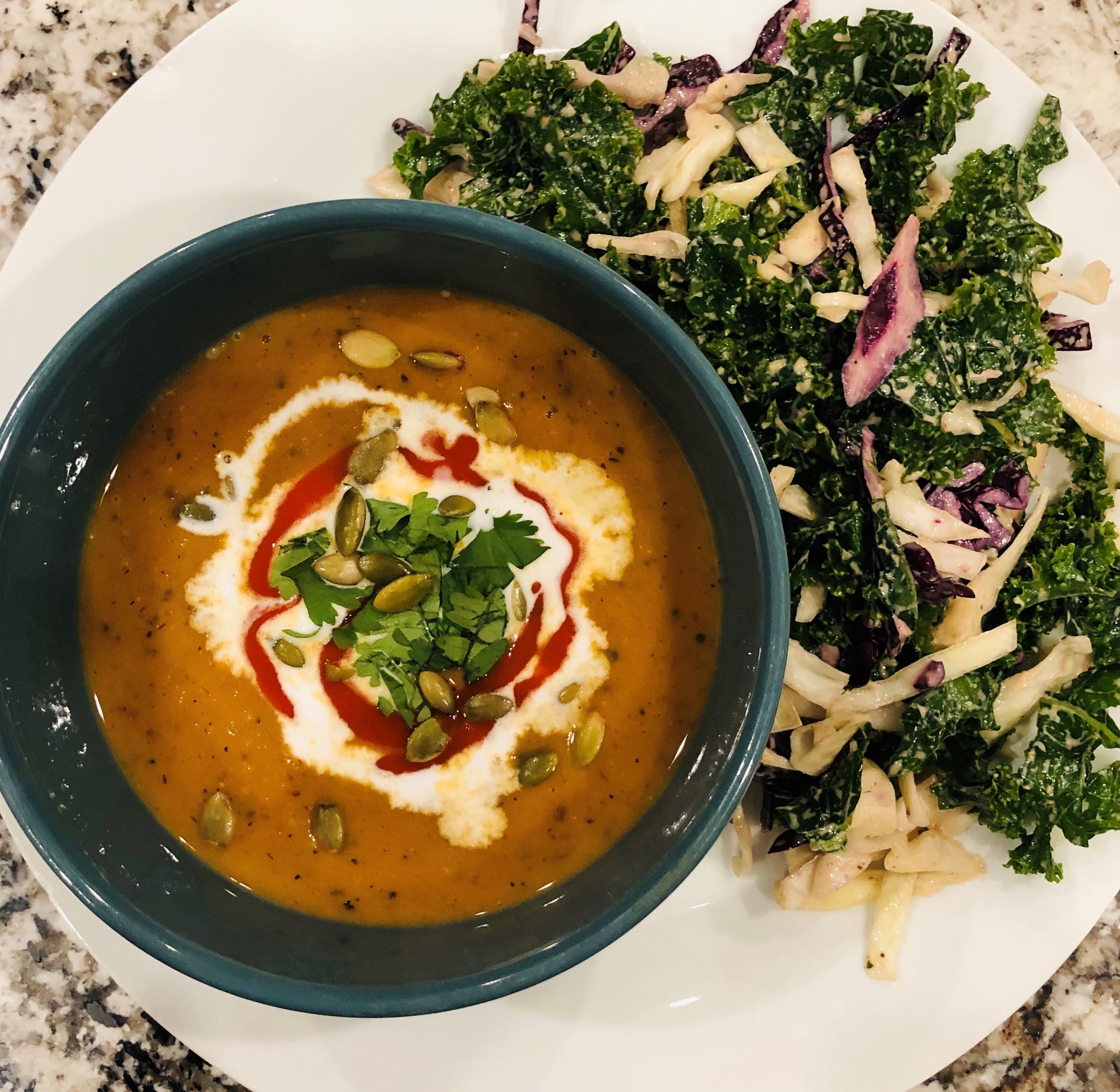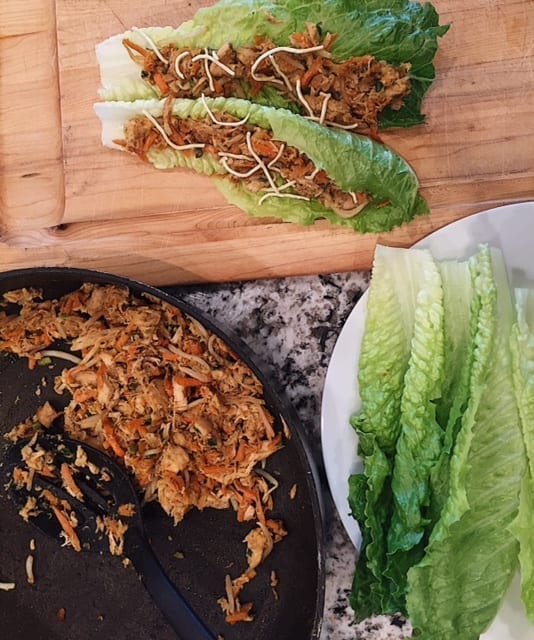What are you most excited about on the first day of fall – sweater weather or soup season?
Soup season for me!!!
I could live in sundresses and flip flops all day, every day, so fall definitely makes me most excited about more soup in my life, not more sweaters!
Along with a couple of clients, I have 2 family members following a gut healing protocol to address some digestive issues, major joint pain, and anxiety. My kitchen is in full bone broth production mode, as this is one of the gut healing superfoods. Six days in and they’re already feeling results!
A few signs it may be time for you to address gut health?
Chronic Fatigue
Digestive Issues
Food Sensitivities
Chronic infections
Weak immune system
Allergies
Mood Swings
Inflammatory Skin Conditions
Depression and Anxiety
Behavioral Disorders
Joint Pain
So what’s the deal with bone broth?
Yeah, yeah, yeah, its the hottest trend right now (along with kombucha) but it’s really just an old-as-the-hills traditional food FINALLY coming back. People (and scientists) are realizing that the modern “foods” are killing us, and that Great Grandma was right!
Bone broth is one of the most important foods to build a healthy gut and strong immune system. Animal bones are rich in minerals and gelatin, soothing to the digestive tract and mucous membranes, and the complete protein is essential for healing and repair.
It is rich in the following amino acids (and more):
- Proline: A precursor for hydroxyproline, which the body uses to make collagen. Proline helps the body break down proteins and helps improve skin elasticity and smoothness (and avoiding wrinkles). It is often recommended for its benefits to the heart, including keeping arteries from stiffening.
- Glycine: Glycine helps form two of the most important substances that make up the gut lining: collagen and gelatin. It helps rebuild tissue that lines the digestive tract, keeping food particles and bacteria inside the gut where they belong, rather than allowing tiny openings to form that pass particles to the bloodstream where they trigger inflammation. Collagen and gelatin help people with food allergies and sensitivities tolerate foods more easily and can soothe the lining of the GI tract in people with inflammatory bowel diseases or indigestion. It is also used to produce glutathione (a valuable antioxidant), for blood sugar regulation and digestion (through bile salt regulation). Promotes muscle growth, together with proline and also repairs and protects joints and cartilage.
- Glutamine: Bone broth is an excellent source of glutamine. Because glutamine is the major fuel source for cells of the small intestine, it has been shown to heal leaky gut in clinical studies and is recommended for all gut healing protocols.
Gut and Immune Health
Chicken soup is a well known remedy for illness, and now modern research understands that 70-80% of the immune system is in the gut. Bone broth is especially helpful because its high gelatin/collagen content supports gut health and its amino acids help reduce inflammation. We aren’t talking about a can or paper package of chicken noodle soup here!
Dr. Campbell McBride, author of Gut and Psychology Syndrome, says that gelatin helps “heal and seal” the gut, and in doing so is helpful for reversing leaky gut syndrome and digestive problems -while simultaneously building the immune system!
Broth vs Bone Broth vs Stock. What’s the difference?
Nourished Kitchen provides a great explanation of the difference between these terms:
- Broth is typically made with meat and can contain a small amount of bones (think of the bones in a fresh whole chicken). Broth is typically simmered for a short period of time (45 minutes to 2 hours). It is very light in flavor, thin in texture and rich in protein.
- Stock is typically made with bones and can contain a small amount of meat (think of the meat that adheres to a beef neck bone). Often the bones are roasted before simmering them as this simple technique greatly improves the flavor. Beef stocks, for example, can present a faint acrid flavor if the bones aren’t first roasted. Stock is typically simmered for a moderate amount of time (3 to 4 hours). Stock is rich in minerals and gelatin.
- Bone Broth is typically made with bones and can contain a small amount of meat adhering to the bones. As with stock, bones are typically roasted first to improve the flavor of the bone broth. Bone broths are typically simmered for a very long period of time (24-48 hours). This long cooking time helps to remove as many minerals and nutrients as possible from the bones. At the end of cooking, so many minerals have leached from the bones and into the broth that the bones crumble when pressed lightly between your thumb and forefinger.
How to Use Broth
Here are some great ways to use broth:
- As a base for soups and stews.
- In a mug by itself as a warm drink.
- As a base for gravy and sauce.
- Use it to cook veggies in for extra nutrients.
- Dehydrate to make your own bouillon powder.
In my opinion, the best way to get broth is to make it yourself. This is the least expensive and most nutrient dense way to get broth if you can find quality (grass fed, organic) bones locally. And yes, there is a huge difference in the soup I’ve made from pastured animal bones vs conventional. Healthy animal = more nutrient dense food!
Bone Broth Recipe
1) Take 3-5 pounds chicken or beef bones – organic (or at least raised naturally), grass fed for best quality. Chicken feet and necks make a very gelatinous broth – if you can stand dealing with the feet… 🙂
*Every time I roast a chicken or turkey the carcass goes into the crockpot for broth.
2) Roast bones at 400* (even the left over carcass) for 30 minutes to enhance flavour.
3) Put roasted bones in large pot or crockpot and cover with 3-4 litres of water. I use a crockpot whenever possible so I don’t have to monitor it, deal with boiling over, etc, and it stays at a low simmer which makes the clearest broth. Boiling bones makes it look “murky” – still edible, just not as appetizing.
4) Add 1/4 cup apple cider vinegar. This alkalinizes the broth and draws minerals out of the bones. (Use white vinegar if you don’t have ACV).
5) Bring pot to a simmer and turn to lowest setting to maintain a simmer (or turn crockpot to low and forget about it – except to monitor water level). Beef bones are best simmered for 48 hours, poultry for 24 hours. Add water as necessary to keep bones covered.
In the last 4 hours, you can add veggies (onion, celery, carrot, parsley, etc…) to add more flavour and nutrients. This is especially good if you drink the clear broth. I tend to make more soups out of mine and add veggies then.
6) When done, cool, strain out the bones, and package for freezing or use in the next 5 days.
Fat that settles on the top can be removed once chilled – depending on how much there is. If the animal has been raised organically (even if not certified, but you know the farmer and farming practices) then keep some of the fat in the soup! This is a natural, nourishing, healthy (gasp?!) saturated fat!
Season to taste with salt, pepper, and herbs and drink as a clear broth, or use it to make hearty meal-in-a-bowl soups!
That’s it! So simple, so good, so nutritious!
Bon(e) Appetit!
B.







